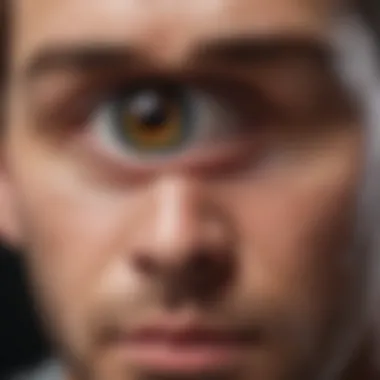Understanding UnitedHealthcare's Vision Plans and Benefits


Intro
Understanding the nuances of vision insurance can seem like navigating a maze. If you’ve ever felt lost in the sea of coverage options and terms, you’re not alone. When it comes to UnitedHealthcare’s vision plans, grasping the core concepts can empower you to make sound decisions for your eye health.
In this guide, we’ll explore everything from key terminologies to the specifics of available plans. Whether you’re a newcomer trying to find your footing in the world of vision insurance or a seasoned consumer looking to reassess your options, this comprehensive overview is designed for you. Let's delve into the details and arm you with the knowledge needed to keep your vision sharp.
Overview of UnitedHealthcare
The landscape of health insurance is a vast one, and within it, UnitedHealthcare stands out as a significant player. Understanding their offerings, particularly in vision care, is essential for anyone looking to safeguard their eye health. UnitedHealthcare doesn’t just offer a product; they provide a comprehensive suite of vision plans aimed at addressing both common and specialized eye care needs. This overview sets the stage to explore the depths of their offerings and helps consumers make informed choices based on specific needs and expectations.
History and Background
Founded in 1977, UnitedHealthcare has grown from a modest operation to a formidable force in the insurance realm, catering to millions across the U.S. Their roots stem from a straightforward aim: to make healthcare more accessible and efficient. Initially concentrating on health care services, they gradually expanded into various domains, including vision care. Over the decades, they've acquired significant platforms and forged partnerships that amplify their reach, enabling them to adapt to the evolving demands of the healthcare landscape.
UnitedHealthcare has paved the way for innovation in the insurance space, not merely keeping up with trends but often dictating them. For instance, they were among the first to integrate telehealth services, a move that greatly enhanced access to care, particularly in eye health consultations.
Current Market Position
Today, UnitedHealthcare is among the top insurance providers, with a market position that reflects its expansion and adaptability. Their vision plans, a crucial component of their offerings, position them as a leading choice for individuals seeking robust eye care coverage. With an extensive network of providers and a variety of plans tailored to fit different lifestyles and budgets, they ensure that comprehensive eye care is not just a privilege but an accessible service for many.
In a competitive market, UnitedHealthcare distinguishes itself by emphasizing a seamless experience for customers, highlighted by easy access to specialists and a straightforward claims process. As the frequency of eye-related issues rises due to lifestyle changes and increased screen time, the relevance of UnitedHealthcare's vision plans has never been more pronounced.
"The best vision plans are those that encompass not only basic eye care but also promote long-term eye health through preventive measures."
With this foundational understanding, the next sections will unpack the significance of vision care, economic impacts, various types of plans available, and their inherent features and benefits.
Importance of Vision Care
Vision care is often overshadowed by other health concerns, yet it plays a central role in our overall well-being. In this section, we’ll delve into two main facets of vision care: its impact on health and the economic implications it carries. Understanding these elements is critical for making informed choices about vision insurance, and by extension, for safeguarding your eye health.
Impact on Overall Health
The connection between vision and health isn’t just about being able to read the fine print or see the scoreboard at a game. Research shows that eye health is a window into the well-being of the entire body. Just as a car enthusiast knows to check the oil, tire pressure, and brakes, individuals must pay attention to their eyes.
When you have regular eye check-ups, healthcare professionals are not just checking for issues like astigmatism or near-sightedness. They might also detect early signs of serious conditions like diabetes, hypertension, or even certain types of cancer. The eyes can reveal a whole lot about what’s brewing under the surface.
- Diabetes: High blood sugar levels can damage blood vessels in the retina. Early detection can lead to timely treatment and potentially save your vision.
- Hypertension: Similar, persistent high blood pressure may cause blood vessels in the eyes to narrow. Identifying this early can help prevent more severe outcomes.
Moreover, neglected vision issues can lead to accidents and injuries. If you squint to see a sign while driving or miss a step on the stairs, the consequences can be dire. Maintaining proper vision aids not only in day-to-day tasks but also in ensuring safety and independence as we go through life.
Economic Implications
On the financial side, the importance of vision care extends beyond just the cost of glasses or contacts. Investing in preventive eye care can reduce long-term medical expenses. In the U.S., eye diseases are projected to cost the healthcare system billions in the coming years. Just think about it—if people had regular eye exams, many conditions could be addressed before escalating into more severe, and more expensive, issues.
- Direct Costs: The cost of treatment for advanced eye conditions can skyrocket compared to regular eye exams and basic preventive care. Individuals without routine check-ups may face significant unexpected expenses down the line.
- Productivity: Poor vision can dampen productivity in work or school settings. Missed work days due to avoidable eye issues can affect not just the individual but also employers and the economy at large.
"Ignoring eye health can lead to significant financial and personal costs, both direct and indirect. Making your vision care a priority is not just a wise health choice, it’s smart economics."
Vision care is intertwined with personal and collective health. By grasping its relevance, consumers can better navigate their choices regarding insurance plans like those offered by UnitedHealthcare. With a deeper comprehension of these issues, individuals can take proactive measures to sustain their vision health and financial well-being.
UnitedHealthcare Vision Plans
The realm of vision care is a significant aspect of overall health that can often be overlooked. UnitedHealthcare's vision plans offer a structured approach to maintaining this critical aspect of health. These plans are not merely financial instruments; they embody a commitment to eye health that touches numerous lives. By detailing coverage options and navigating the complexities of choosing the right plan, UnitedHealthcare aims to equip individuals with the necessary tools and options for handling their vision health.
Understanding the nuances of UnitedHealthcare’s vision plans is essential for anyone looking to safeguard their eyesight. The complexity within their offerings reflects the varied needs of individuals ranging from young families to seasoned professionals. With a variety of coverage types available, the consumer is presented with opportunities tailored to their specific vision requirements and lifestyle.
Types of Vision Insurance Plans
UnitedHealthcare provides a diversified approach to vision insurance through several plan types. Each plan serves different needs and preferences, making it imperative to assess the nuances prior to any selection. Below are the primary offerings available:
- Comprehensive Vision Plans: These plans generally cover routine eye exams, eyewear purchases, and necessary supplementary services. They provide a full suite of care that addresses routine as well as urgent needs.
- Discount Vision Plans: For those who might find full coverage a bit too pricey, discount plans offer a way to obtain services through a network at reduced rates. While the coverage is not as extensive, it still helps in making eye care more affordable.
- Employers Sponsored Plans: Many employers partner with UnitedHealthcare to offer vision care to their employees. These plans often come with group rates which can be more economical, making this an attractive option for individuals looking for coverage through their workplace.
Evaluating the differences among these plans will assist in making informed choices tailored to clients' unique health situations.


Basic vs Specialized Coverage
In understanding UnitedHealthcare’s vision offerings, it's crucial to distinguish between basic and specialized coverage. This distinction can significantly influence both accessibility and financial outlay for vision care.
- Basic Coverage: This form of coverage typically includes routine eye exams, standard lenses, and frames. It addresses the essential needs of vision health and ensures that most individuals have access to foundational eye care.
- Specialized Coverage: This goes above and beyond basic needs, providing options for treatment of specific conditions or advanced eyewear like progressive lenses, specialty frames, or contact lenses catering to unique requirements. For individuals who have complex vision issues or who require immediate interventions, specialized coverage might be the preferred route.
The choice between basic and specialized coverage hinges on individual needs, lifestyle, and budget. Careful consideration of one's vision health can set the stage for optimal choices that align specifically with one’s life demands.
In essence, UnitedHealthcare's vision plans are comprehensive. They offer an array of options, allowing consumers to navigate their specific needs effectively. This tailored approach ensures that whether someone needs routine check-ups or specialized care, they can find a fitting solution within UnitedHealthcare's offerings.
Plan Features and Benefits
When we dig into the nitty-gritty of UnitedHealthcare’s vision plans, the emphasis on plan features and benefits truly shines. Understanding these components not only aids in selecting the right coverage but ensures that consumers know what they can expect when it comes to eye health. In the world of insurance, especially with vision plans, each feature can significantly influence both the quality and affordability of care. Grasping these benefits can also mean the difference between a routine eye check-up being a minor expense or a major financial hurdle.
Routine Eye Exams
Routine eye exams are a cornerstone of any vision plan, including those from UnitedHealthcare. These exams go beyond merely checking if one needs glasses. They offer a comprehensive look at eye health, potentially spotting early signs of serious issues like diabetes or glaucoma.
- Regular check-ups can prevent more severe conditions down the line.
- Most plans cover these exams at least once a year, decreasing the financial burden on members.
- Such preventive measures are critical, especially for those with a family history of eye diseases.
The inclusion of routine exams means you don't need to put off a visit to the optometrist due to cost concerns; it's a proactive step toward maintaining your overall health. After all, as the saying goes, "an ounce of prevention is worth a pound of cure."
Eyewear Coverage
Another pivotal feature of UnitedHealthcare's vision plans is eyewear coverage. This includes the cost of glasses or contact lenses, pivotal for many individuals who rely on vision correction.
- Coverage can vary, with some plans allowing for a set allowance toward frames, while others may offer discounts on prescription lenses.
- It's essential to review the specifics, as certain higher-end frames or specific lens treatments may incur additional out-of-pocket costs.
- For those who rely on the latest technology, the plans frequently include options for stronger lenses or blue light blocking glasses, which are more relevant in today’s digital age.
Eyewear coverage plays a considerable role in both the functionality and the aesthetic of vision correction, so understanding the particulars helps ensure you’re not caught off guard when it’s time to purchase new specs or contacts.
Contact Lens Options
UnitedHealthcare also accommodates those who prefer contact lenses over traditional eyeglasses, providing specific coverage options that cater to this choice.
- Many plans cover the cost of a standard pair of contact lenses, often with an allowance that can be applied once or twice per year.
- Some may require additional fitting fees, which could be a potential hidden cost if not factored in before a fitting appointment.
- Additionally, options like daily disposables or specialty lenses for astigmatism often carry different coverage terms.
Accurate awareness of these details permits better preparation for using contacts. After all, knowledge empowers clients to make informed decisions about their vision, rather than just following the trends others set.
In summary, understanding the features and benefits of UnitedHealthcare's vision plans is crucial for anyone looking to maintain good eye health. Each plan element, from exams to eyewear and contact lens options, comprises a unique part of the overall picture of individual eye care.
Understanding Costs and Premiums
When considering any health insurance—vision included—understanding costs is paramount. It’s not just about grabbing the shiniest plan; it’s about knowing what you’re getting for your buck. Vision care isn’t just a perk; it’s an essential part of overall health. This part discusses how costs break down, what premiums look like, and why these details matter.
Premium Structures
Premiums often serve as the bread and butter of health insurance. They are typically paid monthly, acting like a ticket to entry for the vision benefits you might need. In the context of UnitedHealthcare's vision plans, premium structures can vary significantly based on numerous factors:
- Type of Plan: Plans differ between basic and comprehensive packages, impacting the monthly fee.
- Age: Sometimes, older customers might face higher premiums than younger ones, aligning with the likelihood of needing more frequent eye care.
- Employer Contributions: In some cases, employers foot a part of the bill, cushioning the effect on employees’ wallets.
Premiums can also be influenced by whether a member opts for an in-network provider or decides to go out of network. This can drastically change costs from the outset, effectively tightening or loosening your financial belt.
Out-of-Pocket Expenses
While premiums are critical, they aren’t the only fish in the sea. Out-of-pocket expenses can nip your budget in the bud if you’re not careful. Here are some common out-of-pocket costs associated with UnitedHealthcare’s vision plans:
- Co-Pays: These are fixed amounts that one pays at the time of service. A routine eye exam might have a co-pay, while specialist visits often carry a heftier co-pay rate.
- Deductibles: Before the insurance kicks in, you might be expected to spend a certain amount out of your pocket first. Knowing your deductible can save headaches later.
- Coverage Limits: Some plans may have caps on the number of visits or the dollar amount covered annually. Once you hit that ceiling, you’ll be paying the full fare.
"Education on these various out-of-pocket costs is critical. Understanding limits and potential expenses can help avoid any surprise bills later."
With vision plans like those offered by UnitedHealthcare, it becomes essential to dive into the specifics. Being armed with knowledge helps consumers make informed choices to safeguard their financial health alongside what they can see clearly. Knowing how premiums and out-of-pocket expenses interact can guide one towards the most suitable plan for eye care needs.
Provider Networks


When navigating the world of vision insurance, provider networks play a pivotal role in shaping your experience and access to care. Understanding how these networks operate can mean the difference between a seamless journey to eye health and a frustrating runaround. UnitedHealthcare's vision plans typically include a wide array of providers, creating an extensive network from which members can choose. Knowing who is in-network is essential, as it greatly influences both costs and ease of accessing services.
Choosing In-Network Providers
Selecting an in-network provider can significantly lower your out-of-pocket expenses. For instance, utilizing a provider within UnitedHealthcare's network means that the fees are pre-negotiated, leading to reduced costs for members. This can be quite the money-saver when it comes to routine eye exams or buying eyewear. However, if you choose an out-of-network provider, you may be stuck with a hefty bill, as the insurance will only reimburse a portion—if at all.
While all this might seem straightforward, it does require some careful thought. For example, you might have a preferred optometrist or ophthalmologist who doesn't participate in UnitedHealthcare's network. In such cases, you'll need to weigh whether to stick with your trusted provider or switch to a network provider for better financial benefits. Always remember to check UnitedHealthcare's online directory or app to see if your preferred provider is in-network—it's a game-changer.
Access to Specialists
The access to specialists can differ significantly based on network structures. Within UnitedHealthcare's framework, if you need specialized eye care, finding an in-network ophthalmologist is often a smoother ride. These specialists can handle everything from eye diseases to complex surgical procedures, and being in-network often means better coordination of care, which is critical for sharp decision making.
Specialists often have affiliations with hospitals or clinics, further broadening options for members. For example, if a member has diabetes, it’s essential to have an ophthalmologist who understands the relationship between diabetes and vision conditions. UnitedHealthcare typically provides the necessary tools to connect with these specialized providers effectively.
In summary, while the work to find a suitable in-network provider can seem tedious, the financial benefits and improved access to specialized care are well worth the effort. Remember, doing your homework pays off in the long run.
Navigating the Claims Process
When it comes to using your vision benefits through UnitedHealthcare, navigating the claims process can be a daunting task. Understanding how this process works is essential for maximizing your insurance coverage and ensuring that you don’t end up shelling out more cash than necessary. The claims process is where the rubber meets the road; it’s your pathway for reimbursement for expenses incurred during your vision care.
Understanding Claim Submission
Claim submission is the heart of the process that allows you to get reimbursement for your expenses. Here’s the truth: it can be much simpler than most people think, but it does require some attention to detail. When you visit an eye care professional, they typically submit the claim on your behalf if they’re in UnitedHealthcare’s network. This means you won’t have to lift a finger if everything is done right. However, if you end up seeing a provider out-of-network or if they don’t submit the claim, you will need to fill out the forms yourself and send them in.
To make sure your claim is processed smoothly, keep these points in mind:
- Document Everything: Retain all receipts and any relevant paperwork from your visit. Even notes taken during consultation could prove useful.
- Know Your Benefits: Familiarize yourself with your coverage limits and what types of services are covered under your plan. This helps avoid any surprises when the claim is processed.
- Fill Out Forms Accurately: Ensure that the forms are completely filled out and double-check all information for errors to prevent delays.
Common Challenges
While the claims process is generally straightforward, there are challenges that can make it bumpy. Having a grasp on these potential pitfalls can save you from headaches down the line. Here are some common issues you might encounter:
- Miscommunication: Sometimes, there can be a disconnect between what you think is covered and what the provider believes is covered. Always verify with both parties before proceeding.
- Incomplete Documentation: Submitting claims without all the necessary documents can lead to denials. This is why it’s crucial to keep track of all paperwork together and organized.
- Delays in Processing: Claims can sometimes take longer than anticipated to process. If you’ve submitted everything correctly, it’s worth calling customer support to check on the status.
"Navigating the claims process not only affects your immediate reimbursement but also lays the groundwork for your long-term relationship with the insurance provider."
- Out-of-Network Providers: If you choose to go to an outside provider, be prepared for some claim submission hoops to jump through. Make sure that you understand the implications early on.
By keeping these considerations in mind, you can navigate the claims process with greater ease. It ensures that you won’t leave any money on the table when it comes to using your vision insurance with UnitedHealthcare.
Customer Support and Resources
Customer support serves as a crucial bridge between consumers and the services they navigate, especially when it comes to health insurance like UnitedHealthcare's vision plans. Accessing reliable resources and knowledgeable help can significantly ease the anxiety related to managing eye care coverage. With vision health often tied closely to overall well-being, understanding how to effectively utilize customer support can empower members to make informed decisions about their eye care needs.
Access to Information
UnitedHealthcare places a strong emphasis on providing clear and accessible information to its members. The availability of resources is pivotal for understanding policy details, benefits, and nuances that may be specific to individual plans.
Documents such as the benefit summary and policy brochures can often be found online, allowing members to access this information from the comfort of their homes. These materials typically outline:
- Coverage details: What’s included in the plan, limits, and exclusions.
- Network providers: A list of eye care professionals who accept UnitedHealthcare coverage.
- Plan options: Information on various tiers or types of vision plans offered.
Moreover, UnitedHealthcare provides an online portal where members can log in to view their account details, check claims status, and access personalized information. This digital approach not only enhances convenience but also encourages members to engage with their health care decisions actively.
Contacting Support
Should members hit a bump in the road when accessing information or need further clarity, reaching out to customer support is straightforward. UnitedHealthcare offers multiple channels for making contact, ensuring that help is just a phone call or mouse click away.
Members can:
- Call the support hotline: A dedicated customer service line is available, providing personalized assistance.
- Utilize the live chat feature: For those who prefer digital communication, having real-time help via chat can be handy.
- Email inquiries: If more in-depth clarifications are needed, emailing customer support can be effective, allowing members to articulate their specific questions.
This multi-faceted communication strategy enables a smooth flow of information and aids in resolving any potential issues that might arise with claims or understanding coverage.


A well-informed member is a confident member. Access to robust support resources transforms potential confusion into clarity, ultimately ensuring smoother navigation through the vision care landscape.
Frequently Asked Questions
Frequently asked questions play a critical role in understanding vision insurance, particularly when it comes to UnitedHealthcare’s plans. These FAQs help demystify almost everything related to eye care coverage. Addressing the concerns of both newcomers and seasoned policyholders allows for informed decision-making. It acts as a bridge between complex jargon and the straightforward information that patients or policyholders truly need.
Common Concerns
Many people have anxieties about their vision insurance, and it’s wise to recognize these common concerns. Here are a few typical worries:
- Coverage Limitations: Is yearly coverage sufficient? What if I need more than an annual exam?
- Pre-Existing Conditions: How do pre-existing conditions affect the insurance coverage?
- Riders and Exclusions: What are riders? Are there exclusions that I should know about?
- Eligibility: Does everyone qualify for a plan, and what about dependents?
Each of these concerns warrants careful consideration as they align closely with individual needs. Addressing these head-on can simplify the experience and make the path to vision wellness smoother.
Clarifications on Coverage
Fulfilling the needs of patients involves understanding the specifics of what the coverage entails. Here are important points to clarify:
- Routine Eye Exams: Coverage typically includes annual eye exams but may vary by the plan. Knowing the frequency allowed helps in planning ahead.
- Eyewear and Devices: Many plans come with a specific allowance for eyewear and corrective devices, but the details can differ. Understanding the limit can save out-of-pocket costs.
- Application of Benefits: How do benefits apply to major works like LASIK or other surgical procedures? It’s insightful to read the fine print here.
- In-Network vs. Out-of-Network: Understanding that coverage may differ significantly based on provider networks can save you from unexpected expenses.
Having clear answers to these coverage clarifications not only helps you make the right choices but also ensures that you are maximizing the benefits provided by UnitedHealthcare.
"In the landscape of health insurance, knowledge is power—especially when it comes to understanding your coverage options."
By addressing FAQs, UnitedHealthcare gives the necessary tools to assist consumers in navigating through their vision plans with confidence.
Comparative Analysis of Vision Plans
When it comes to selecting a vision plan, having a clear understanding of what different providers offer can make all the difference. A comparative analysis of vision plans sheds light on prospective pros and cons, enabling consumers to make more informed choices about their coverage. Knowing how UnitedHealthcare stacks up against its competitors is crucial, especially given the complex landscape of health insurance where variations in coverage can directly affect accessibility and quality of care.
This analysis highlights critical elements such as coverage options, costs, and provider networks to help consumers navigate their choices. With vision care affecting millions, understanding how different plans measure up in terms of benefits and flexibility is essential.
UnitedHealthcare vs Competitors
UnitedHealthcare’s vision plans can be seen as robust contenders in a market filled with diverse options. For instance, many competitors like VSP and EyeMed emphasize particular features that might appeal to specific demographics.
- Coverage Types: While UnitedHealthcare offers an array of both basic and specialized plans, VSP mainly focuses on comprehensive vision care without additional complexities. Meanwhile, EyeMed provides more customizable plans tailored to unique needs.
- Claims Process: UnitedHealthcare often receives acclaim for its streamlined claims process, but there are grievances about paperwork needing to be meticulous. In contrast, competitors like VSP are often noted for faster processing but provide less insight into claim status.
- Costs and Premiums: Price wise, UnitedHealthcare competes well; however, depending on the state, there might be fluctuations in premium rates. EyeMed, on the other hand, tends to flow with competitive pricing, making it appealing but with limited usability in certain areas.
Each provider has its own strengths and weaknesses, tailoring to different customer needs. It’s wise for consumers to explore each option thoroughly, weighing the benefits alongside the costs.
Evaluation of Benefits
In assessing the benefits of UnitedHealthcare versus its competitors, we need to focus on several key points. By evaluating these factors, potential customers gain insight into what to expect:
- Routine Eye Exams: Utilizing UnitedHealthcare often ensures that members have more frequent exams without significant out-of-pocket cost, which is a critical aspect considering regular check-ups can catch issues early.
- Eyewear and Contacts: The eyewear allowance from UnitedHealthcare can be appealing, mainly if one needs glasses regularly. The benefits for contact lenses can also be substantial, offering a decent range to choose from, unlike some plans that emphasize one over the other.
- Specialist Access: UnitedHealthcare boasts a broader network of eye care specialists, which may be a crucial factor if finding an eye doctor with convenience is a priority.
The benefits detailed here are critical in guiding decision-making for consumers. They can significantly impact overall vision health and budget management, leading to a healthier lifestyle in general.
"Just because a plan is cheaper doesn’t mean it’s better. Consider the full package when evaluating vision insurance."
Arming yourself with these comparisons can help sort through the noise when selecting the right vision plan, ensuring your choices align with your health needs and financial priorities.
Long-term Considerations
In an era where preventive care becomes increasingly pivotal, understanding the long-term implications of vision insurance, particularly those offered by UnitedHealthcare, is fundamental. Choosing the right vision plan isn't just a decision made for the here and now; it's an investment in future eye health and overall well-being. With vision issues being one of the leading causes of disability globally, the right insurance can mean the difference between receiving timely treatment or facing significant challenges in later years.
Having a solid vision plan can lead to ongoing, routine eye exams, which help catch potential problems before they escalate into serious conditions that are more difficult and costly to manage. Regular check-ups can identify issues such as glaucoma or diabetic retinopathy at an early stage. So, it’s not just about what you can see right now, but about laying the groundwork for a healthier tomorrow.
Additionally, many plans offer extensive benefits for eyewear and contact lenses. When these elements are factored into the long term, the costs can add up quickly if not adequately covered. Thus, weighing options today can yield both immediate satisfaction and long-reaching health benefits. Navigating these plans may seem daunting, but understanding potential long-term costs and savings becomes a guiding principle.
Future of Vision Insurance
The landscape of vision insurance is shifting, just like any other segment of the healthcare industry. There’s a growing trend toward integrating telehealth services into vision care. Virtual consultations for eye health are gaining traction and can present various opportunities for plans to adapt. This means less time spent in waiting rooms and more convenience for those with busy schedules. Remote diagnosis for conditions such as dry eyes or allergies is proving advantageous.
Furthermore, technology's impact cannot be understated. The advent of advanced diagnostic tools is improving how vision problems are detected and treated. As plans evolve, their coverage may expand in alignment with these advancements, making them more robust and comprehensive. Early adoption of such innovations could mean enhanced care for members looking to ensure their vision remains sharp over the years.
Trends Affecting Coverage Options
Several trends will undoubtedly shape the future of coverage options within UnitedHealthcare's vision plans.
- Increased Focus on Prevention: There is a surge in value placed on preventive care as awareness grows about its benefits. Plans are likely to begin offering incentives for regular eye exams and healthy lifestyle choices.
- Customization of Plans: Consumers are becoming more informed and, in turn, expect higher levels of customization in the insurance products they choose. UnitedHealthcare may respond by allowing more tailored plans depending on individual needs, lifestyle, or even family history.
- Integration with Health Plans: Expect to see a integration between vision insurance and other health insurance offerings. This could open the door to comprehensive strategies that blend general health with eye care, leading to more cohesive approaches to overall health management.
- Costs and Accessibility: Like any other insurance, costs and accessibility will continuously influence choices. Affordability remains a critical concern. Plans may likely develop novel methods to make vision care more accessible, perhaps through reduced premiums or enhanced benefits.







